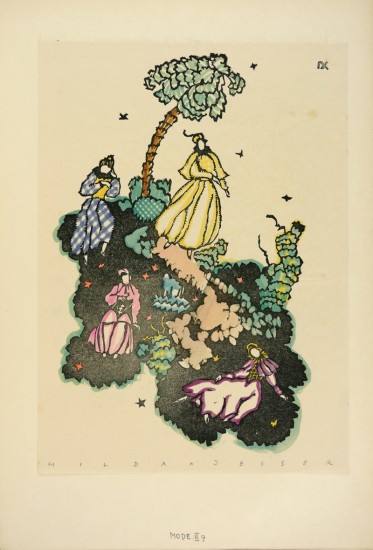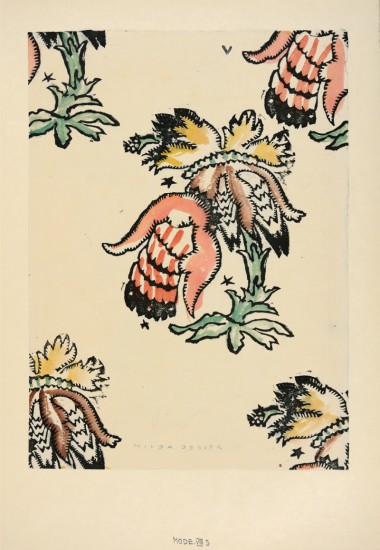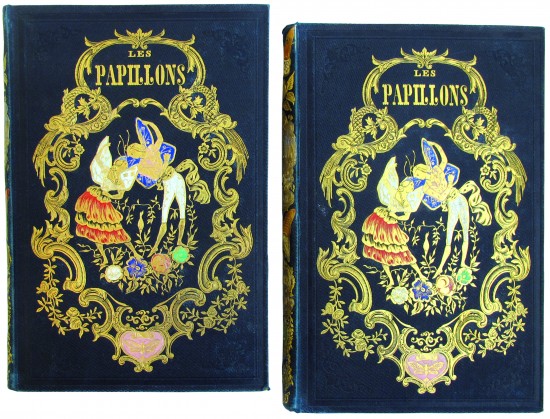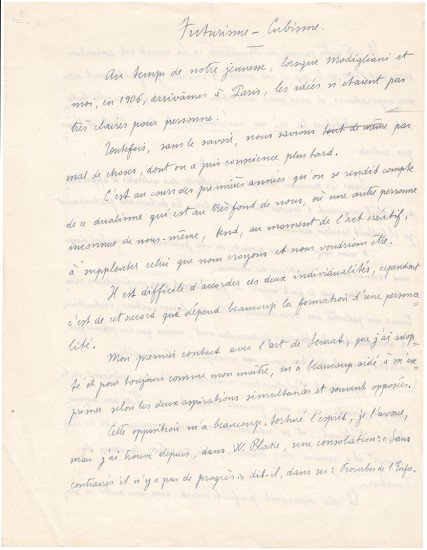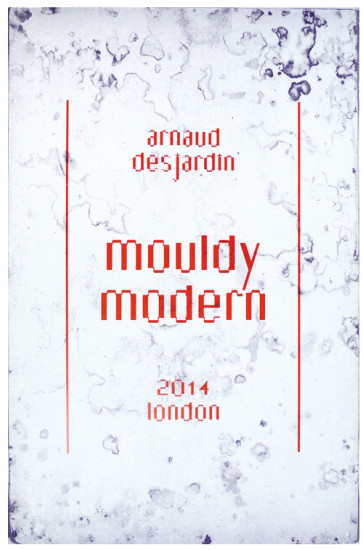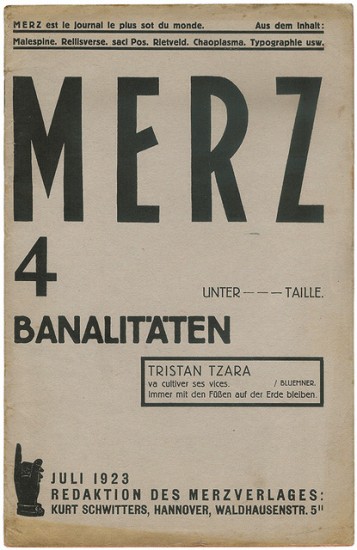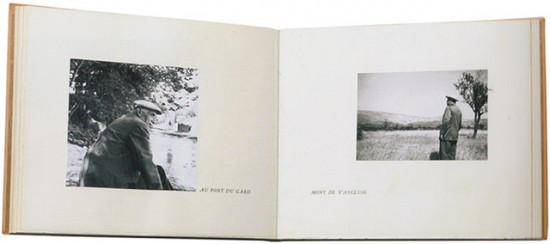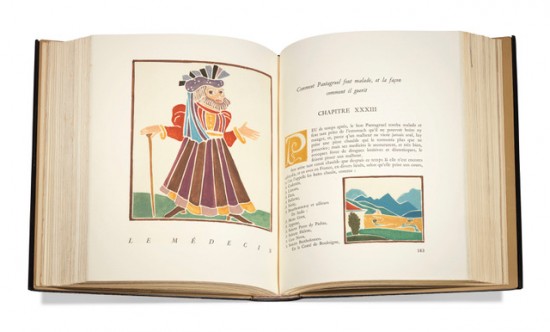Mode 1914/5. Herausgegeben von Prof. Josef Hoffmann unter Mitwirkung von Lehren und Schülern der Weiner Kunstgewerbeschule und den Künstlerischen Mitarbeiten der Wiener Werkstaette
Wiener Werkstatte
Vienna. Verlag von Eduard Kosmack. 1915
Sold
The publisher's unique example of the very rare hand-coloured Wiener Werkstätte fashion portfolio 'Mode'.
From the edition limited to 50 copies (only 35 for sale), with this unique copy assembled for the publisher Eduard Kosmack including the best pulls of the prints and five additional prints not used in the published edition (see transcribed colophon below); this example includes captions to each plate providing the Hefte and plate numbers.
'To the age its art; to art its freedom.' (Motto of the Wiener Werkstätte).
This very rare fashion portfolio was produced by the fashion department of the Wiener Werkstätte under the aegis of Josef Hoffmann at a time when the domestic Austrian market for fashion was growing. The contributors were the teachers and students of the department, many of them young women. The designs they produced vary enormously in stylistic terms, ranging bertween those influenced by Expressionism and Die Brücke and those influenced by the Parisian designs of Paul Poiret; many of the designs - and it must be understood that the majority of the contributors were not fashion designers in any traditional sense - demonstrate remarkable originality in terms of methodology, content and design.
All copies of 'Mode' differ necessarily: the prints were coloured by hand and were printed by the twenty-five individual contributors themselves. The present example features markedly different colouring (as well as some minor differences in captioning) and printing to that exhibited at the Germanisches Nationalmuseum Nürnberg in 1984 and depicted in the catalogue 'Wiener Charme. Mode 1914/15. Graphiken und Accessoires'. In addition, the Nürnberg copy does not include the hand-written title leaf with the colophon verso present here which adds to the bibliographical record - an article published in April 1915 in the 'Neue Badische Landeszeitung' provides some of the few extant details - concerning 'Mode'. While the catalogue Wiener Charme suggests that 'Mode' was not an official production of the Wiener Werkstätte, the manuscript title makes it clear that 'Mode' was produced under the aegis of Josef Hoffmann and the contributors were both the students and the teachers at the Werkstätte's newer iteration, the Kunstgewerbe Schule. The contents leaf for each Heft is here pasted to the inner board of the portfolio and the order of the first three unnumbered and dated Hefte differs from that given in the Nürnberg copy.
The twenty-five contributors to the work and the number of prints they contributed are as follows: Maria Likarz (11), Fritzi Löw (18), Irene 'Reni' Schaschl (15), Grete von Noë / Noé (5), Eduard Josef Wimmer (3), Arnold Nechansky (1), Dagobert Peche (7), Anny Schröder (17), Oskar Strnad (1), Gustav Tejcken (2), Mathilde 'Hilde' Flögl / Flöge (2), Hilda Jesser (17), Max Schnischek (6), Ernst Lichtblau (2), Paul Thomas (2), Lotte Colm / Calm (11), Felice Rix (6), Ada Helena Gabler (1), Wilhelm Foltin (2), Otto Lendecke (5), Gertrude Weinberger (1), Gabi Möschl (5), Josef Gabriel (2), Mary Ilse Lodron (1) and Wally Wieselthier (1).
The additional prints in the present example are: linocut by Maria Likarz inscribed in ink: 'Probedruck. Ausser der Reihe. Nicht in der Auflage enthalten.'; woodcut by Dagobert Peche inscribed: 'MODE. VII 4. Probedruck. In der Auflage nicht enthalten.'; woodcut by Anny Schröder, signed in ink and inscribed: 'Probedruck. Nicht in der Auflage. MODE. VIII 7'; linocut by Hilda Jesser, initialled in pencil and inscribed in ink: 'MODE. VIII 8. Probedruck. Nicht in der Auflage enthalten.'; linocut by Hilda Jesser, signed in capitals in pencil and inscribed in ink: 'MODE IX 8 Andere Kolierung.'.
As stated previously, 'Mode' is extremely rare and we can locate only this copy at auction in the last 35 years; in commerce the only additional copy we locate is the example sold by Christian Neberhay in 1965, that used in the Nürnberg exhibition. In institutional terms we locate only a single copy, that at the Bibliothek des Österreichischen Museums für angewandte Kunst.
'The foreign Expressionists had achieved some of their most powerful statements through the medium of woodcut; the Austrians picked up the superficial style and used it for fashion plates.' (Kallir).
'Die Mode erschien von November 1914 - Dezember 1915 in 12 Heften von denen jedes 12 Original Holz- und Linol-Schnitte und Rädierungen enthält. Der Druck erfolgte auf der Handpresse der Wiener Kunstgewerbe Schule. - Die Blätter wurden von den signierenden Künstlern zum Teil mit der Hand Koloriert. Die Ausgabe erfolgte nur in der Ausstattung des beiliegenden Heftes. Die Auflage betung 50 Exemplare von denen 35 in der Handelgelangten. Das vorliegende Exemplar ist das für den Verleger besonders hergestellte, das ausser den besten Drucken auch einige in der Auflage nicht verwendete Blätter (Unicate) enthalt.' (Manuscript colophon on verso of title).
'The fashion department ... made its debut at the Werkstätte's Karlsbad branch around 1910 and was then formally introduced to Vienna the following year. Originally incorporated in the Neustiftgasse building, the fashion division was given its own headquarters next door to the Graben salesroom in 1911, and by 1914 it had expanded to the point that it was upgraded to 'factory' status and required separate production facilities on the Johannesgasse.' (Kallir).
' … Von den letzeren sei hier vorwiegend berichtet und von diesen wieder in erster Linie von den rein künstlerischen. - Das Originellste leistete wohl die Gruppe Wiener Künstler, die bei Eduard Kosmak (Wien) seit Dezember bis jetzt 4 Mappen von je 12 losen Blättern unter den anspruchlosen Titel Moden, Wien 1914 - 1915 herausgaben. Die erste Mappe wurde in 100, alle weiteren nur in 50 Exemplaren gedruckt. Auf eine Massenbeeinflussung rechnen sie also nicht, wohl nur auf eine mittelbare durch erste Schneidergeschäfte. Die Blätter dieser Hefte sind hauchfeines Japanpapier und die Entwürfe sind zum größten Teil von den Künstlern selbst in Holz geschnitten, ja wahrscheinlich werden auch der Druckabzüge (meist farbige) unter ihrer persönlichen Leitung gemacht. Neben den Holzschnitten enthalten die Mappen noch Kaltnadel-Radierungen und Lithographien, also alles 'Originale'. Was geben sie nun aber, diese 'Originale'? Das ist eigentlich eine schwerige Frage. Man muß gut orientiert sein in der Kunstbewegung der letzen 10 Jahre, um den Zeichnungen an sich überhaupt, ohne Bezug auf die Mode, gerecht werden zu können. Man muß die graphischen Blätter der Deutschen Künstlervereinigung DIe Brücke gekannt haben, man muß auch etwas vom alten und neuen japanischen Holzschnitt und noch allerlei von einigen anderen Techniken verstehen. Eigentlich ein bißchen viel verlangt! Dann wird man aber aber durch die bizarre Linienführung hindurch sich ganz gut eine tragbares Kleid vorstellen können. Auf jedem Blatt findet sich irgendeine wirklich neue Anregung, die ein geschickter Kleiderkünstler mit Erfolg verwerten könnte.' (Margarete Driesch, 'Deutsche und österreichische Kleiderbilder' published in the Neue Badische Landeszeitung, Mannheim, 15th April 1915).
'Kokoschkas Tendenz zur expressiven Flächenhaftigkeit ist auch charakteristisch für die Modegraphiken von 1914/15, wobei sich einige Künsterlinnen enger an Kokoschkas Graphiken orientierten; wie Hilda Jesser mit ihren beiden Blättern, auf denen Figuren und ein Baum einander zugeordnet werden: Blatt 6/9 und Blatt 7/11; wieterhin Maria Likarz mit ihren Hutmodellen auf Blatt 4/4, Wally Wieselthiers Blatt 12/12, auf dem drei Figuren auf verschiedene Hintergrundornamente gesetz sind, oder Grete von Noë, die auf den Blättern 9/1 und 12/4 jeweils eine Einzelfigur en face in eine Landschaft stellt, auch Lotte Calms Blatt 12/1 mit einer Halbfigur vor Fenster gehört in diese Reihe eines ornamentsalen Flächenstils.' (Wiener Charme pg. 33).
[see Wiener Charme: Mode 1914/15, Graphiken und Accessories by Elisabeth Rücker, 1984; see also Viennese Design and the Wiener Werkstätte by Jane Kallir, 1986].
From the edition limited to 50 copies (only 35 for sale), with this unique copy assembled for the publisher Eduard Kosmack including the best pulls of the prints and five additional prints not used in the published edition (see transcribed colophon below); this example includes captions to each plate providing the Hefte and plate numbers.
'To the age its art; to art its freedom.' (Motto of the Wiener Werkstätte).
This very rare fashion portfolio was produced by the fashion department of the Wiener Werkstätte under the aegis of Josef Hoffmann at a time when the domestic Austrian market for fashion was growing. The contributors were the teachers and students of the department, many of them young women. The designs they produced vary enormously in stylistic terms, ranging bertween those influenced by Expressionism and Die Brücke and those influenced by the Parisian designs of Paul Poiret; many of the designs - and it must be understood that the majority of the contributors were not fashion designers in any traditional sense - demonstrate remarkable originality in terms of methodology, content and design.
All copies of 'Mode' differ necessarily: the prints were coloured by hand and were printed by the twenty-five individual contributors themselves. The present example features markedly different colouring (as well as some minor differences in captioning) and printing to that exhibited at the Germanisches Nationalmuseum Nürnberg in 1984 and depicted in the catalogue 'Wiener Charme. Mode 1914/15. Graphiken und Accessoires'. In addition, the Nürnberg copy does not include the hand-written title leaf with the colophon verso present here which adds to the bibliographical record - an article published in April 1915 in the 'Neue Badische Landeszeitung' provides some of the few extant details - concerning 'Mode'. While the catalogue Wiener Charme suggests that 'Mode' was not an official production of the Wiener Werkstätte, the manuscript title makes it clear that 'Mode' was produced under the aegis of Josef Hoffmann and the contributors were both the students and the teachers at the Werkstätte's newer iteration, the Kunstgewerbe Schule. The contents leaf for each Heft is here pasted to the inner board of the portfolio and the order of the first three unnumbered and dated Hefte differs from that given in the Nürnberg copy.
The twenty-five contributors to the work and the number of prints they contributed are as follows: Maria Likarz (11), Fritzi Löw (18), Irene 'Reni' Schaschl (15), Grete von Noë / Noé (5), Eduard Josef Wimmer (3), Arnold Nechansky (1), Dagobert Peche (7), Anny Schröder (17), Oskar Strnad (1), Gustav Tejcken (2), Mathilde 'Hilde' Flögl / Flöge (2), Hilda Jesser (17), Max Schnischek (6), Ernst Lichtblau (2), Paul Thomas (2), Lotte Colm / Calm (11), Felice Rix (6), Ada Helena Gabler (1), Wilhelm Foltin (2), Otto Lendecke (5), Gertrude Weinberger (1), Gabi Möschl (5), Josef Gabriel (2), Mary Ilse Lodron (1) and Wally Wieselthier (1).
The additional prints in the present example are: linocut by Maria Likarz inscribed in ink: 'Probedruck. Ausser der Reihe. Nicht in der Auflage enthalten.'; woodcut by Dagobert Peche inscribed: 'MODE. VII 4. Probedruck. In der Auflage nicht enthalten.'; woodcut by Anny Schröder, signed in ink and inscribed: 'Probedruck. Nicht in der Auflage. MODE. VIII 7'; linocut by Hilda Jesser, initialled in pencil and inscribed in ink: 'MODE. VIII 8. Probedruck. Nicht in der Auflage enthalten.'; linocut by Hilda Jesser, signed in capitals in pencil and inscribed in ink: 'MODE IX 8 Andere Kolierung.'.
As stated previously, 'Mode' is extremely rare and we can locate only this copy at auction in the last 35 years; in commerce the only additional copy we locate is the example sold by Christian Neberhay in 1965, that used in the Nürnberg exhibition. In institutional terms we locate only a single copy, that at the Bibliothek des Österreichischen Museums für angewandte Kunst.
'The foreign Expressionists had achieved some of their most powerful statements through the medium of woodcut; the Austrians picked up the superficial style and used it for fashion plates.' (Kallir).
'Die Mode erschien von November 1914 - Dezember 1915 in 12 Heften von denen jedes 12 Original Holz- und Linol-Schnitte und Rädierungen enthält. Der Druck erfolgte auf der Handpresse der Wiener Kunstgewerbe Schule. - Die Blätter wurden von den signierenden Künstlern zum Teil mit der Hand Koloriert. Die Ausgabe erfolgte nur in der Ausstattung des beiliegenden Heftes. Die Auflage betung 50 Exemplare von denen 35 in der Handelgelangten. Das vorliegende Exemplar ist das für den Verleger besonders hergestellte, das ausser den besten Drucken auch einige in der Auflage nicht verwendete Blätter (Unicate) enthalt.' (Manuscript colophon on verso of title).
'The fashion department ... made its debut at the Werkstätte's Karlsbad branch around 1910 and was then formally introduced to Vienna the following year. Originally incorporated in the Neustiftgasse building, the fashion division was given its own headquarters next door to the Graben salesroom in 1911, and by 1914 it had expanded to the point that it was upgraded to 'factory' status and required separate production facilities on the Johannesgasse.' (Kallir).
' … Von den letzeren sei hier vorwiegend berichtet und von diesen wieder in erster Linie von den rein künstlerischen. - Das Originellste leistete wohl die Gruppe Wiener Künstler, die bei Eduard Kosmak (Wien) seit Dezember bis jetzt 4 Mappen von je 12 losen Blättern unter den anspruchlosen Titel Moden, Wien 1914 - 1915 herausgaben. Die erste Mappe wurde in 100, alle weiteren nur in 50 Exemplaren gedruckt. Auf eine Massenbeeinflussung rechnen sie also nicht, wohl nur auf eine mittelbare durch erste Schneidergeschäfte. Die Blätter dieser Hefte sind hauchfeines Japanpapier und die Entwürfe sind zum größten Teil von den Künstlern selbst in Holz geschnitten, ja wahrscheinlich werden auch der Druckabzüge (meist farbige) unter ihrer persönlichen Leitung gemacht. Neben den Holzschnitten enthalten die Mappen noch Kaltnadel-Radierungen und Lithographien, also alles 'Originale'. Was geben sie nun aber, diese 'Originale'? Das ist eigentlich eine schwerige Frage. Man muß gut orientiert sein in der Kunstbewegung der letzen 10 Jahre, um den Zeichnungen an sich überhaupt, ohne Bezug auf die Mode, gerecht werden zu können. Man muß die graphischen Blätter der Deutschen Künstlervereinigung DIe Brücke gekannt haben, man muß auch etwas vom alten und neuen japanischen Holzschnitt und noch allerlei von einigen anderen Techniken verstehen. Eigentlich ein bißchen viel verlangt! Dann wird man aber aber durch die bizarre Linienführung hindurch sich ganz gut eine tragbares Kleid vorstellen können. Auf jedem Blatt findet sich irgendeine wirklich neue Anregung, die ein geschickter Kleiderkünstler mit Erfolg verwerten könnte.' (Margarete Driesch, 'Deutsche und österreichische Kleiderbilder' published in the Neue Badische Landeszeitung, Mannheim, 15th April 1915).
'Kokoschkas Tendenz zur expressiven Flächenhaftigkeit ist auch charakteristisch für die Modegraphiken von 1914/15, wobei sich einige Künsterlinnen enger an Kokoschkas Graphiken orientierten; wie Hilda Jesser mit ihren beiden Blättern, auf denen Figuren und ein Baum einander zugeordnet werden: Blatt 6/9 und Blatt 7/11; wieterhin Maria Likarz mit ihren Hutmodellen auf Blatt 4/4, Wally Wieselthiers Blatt 12/12, auf dem drei Figuren auf verschiedene Hintergrundornamente gesetz sind, oder Grete von Noë, die auf den Blättern 9/1 und 12/4 jeweils eine Einzelfigur en face in eine Landschaft stellt, auch Lotte Calms Blatt 12/1 mit einer Halbfigur vor Fenster gehört in diese Reihe eines ornamentsalen Flächenstils.' (Wiener Charme pg. 33).
[see Wiener Charme: Mode 1914/15, Graphiken und Accessories by Elisabeth Rücker, 1984; see also Viennese Design and the Wiener Werkstätte by Jane Kallir, 1986].
12 fascicules in 1 vol. Folio. Leaf with manuscript title in black ink recto and colophon verso and 144 linocut, woodcut, lithograph or etched plates on handmade laid tissue, each with additional colouring by hand by the relevant artist, a large number signed or initialled in pencil by the relevant artist, with the stamped plate number, all mounted to large sheets of stiff japon card and with manuscript Hefte and plate number beneath in blue or black ink; printed list of contents of each Hefte ruled in red and pasted to inner boards of original portfolio. (Sheet size: 376 x 254 mm; plate size: c.304 x 213 mm). Loose as issued in original publisher's marbled board portfolio with gilt flaps, square title lable mounted to front board, inner boards with pasted on list of plates for each fascicule.
#41934


